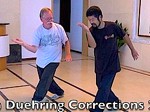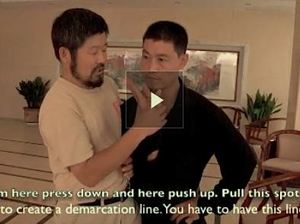-
The elbow rubs against the side of the body. He had us practice that and pay attention to it. I don’t yet know why it is important, but I will work to remember to do it this way
-
the foot of the side going forward drives the movement (without moving much).
-
The body or parts of the body are often very fixed and you don’t move in space at all, and by using that constraint, then create pressure and the pressure goes through your body more. When you let the body part move, then the power leaks out. I need to not let my body move so that when I apply power, it goes through my body in the desired path, rather than leaking out near the parts that move. He did a vastly more subtle version where it was almost more energetic, and as if he had 2 layers in his body, an outside and an inside. I don’t understand it at all and I don’t think it is where I am yet. He also showed what it was to be equally full everywhere, and to keep that even as moving. These were super cool, very enlightened things. Maybe after many years of hard work I can start to work on these.
-
Often there is a body part that doesn’t move at all (and more, keeps the same pressure and direction of pressure, if I am in contact with someone), and then other parts move. I saw this illustrated in a place where we stepped forward with our qua hinging down below someone as our hand stayed fixed against them. Another example in a moving step positive circle … I come in on them in the part where the arm comes in, and then extend the arm after I step.
-
Direction – I still need to work on better aim (a lot). However, sometimes I get it pretty well (I think). Easier for me when the person is directly in front of me (but I still vary up/down, even then). But the idea of aiming through a spot was helpful for me. This was similar to a pole exercise Kelvin did, where you both pushed on the pull in a push-a-war (instead of tug a war). By aiming through their hand, the power transmitted beautifully. There was also spiraling the power in, which I can do a little bit of, but I don’t understand why it works at all, only that it does 🙂
-
Pung. The sense of stretching in all directions. You can also stretch inwards, and I believe (not sure) that there is often a sense of compression and expansion which sometimes alternate. I should pay more attention to see when it is one or the other so that I am clear. Another example is The arch of the legs & the exercise to pull the Qua away from each other … actively pull the qua away from each other or from one or the other if it is a fixed point. I think stretching is something I need to pay more attention to … he’s mentioned it to me twice in the zoom class, and also has mentioned that my body is too loose. This is probably one of the bigger takeaways for me. (Although there are so many!)
-
In my own body and when watching him …. do I know what the fixed point is? He made the comment in six sealing four closing that the fixed point could be the back qua (or the front, but he showed mostly with the back qua fixed). I believe the qua is fixed and the muscles move around it, enabling extra motion.
-
in opening the qua … I need to be more strict in my standards. Don’t let my centerline give at all, and my qua doesn’t move much. Then stretch more to get a little extra movement. And look at my shoulders … have they moved forward relative to my qua at all? If so, then I was not strong enough. This also makes me more aware of the facing of the hips .. because then that is also the facing of the torso … I let my waist turn a small amount many times … I need to use my qua, and also sometimes my foot placement. For example, before I would step straight forward more often, and I see now that the feet are typically not straight forward on a line, with the hips completely facing that line.
-
1 cannot see 3. The upper body relates to the qua/dantien and they relate to the feet. But if the upper body relates to the feet, you lose power. Similarly the shoulder relates to the elbow to the hand.
-
Feet facing mostly forward ( I was too turned out)
-
Pung, be more actively full. I need to work on this more and actively. It is not my instinct.
-
the push is not in the arms (we always say this!)
-
My line / Point … wants to veer left. Then right. Then up. Then gets stuck in the wrist … go through the fingers. I think I need to practice with a stick.
-
Things must be so tight that there are no other possibilities. This was very interesting and I did feel it.
-
He pushes me and my qua is a gear, but my elbow must move in and screwdriver ever so slightly.
-
He slaps arm and qua redirects (note, shoulder also goes down as a consequence of the qua)
-
Push from the qua … but there is no push!! It is the rotation of the gear, in response to a different imaginary gear. This is the tai chi symbol. It feels like this is the beginning of a big idea.
-
Then there is a lock of the qua to the elbow. A spiral drilling from shoulder, elbow, wrist into the line
-
In passing – Curve spine … huge curve, Head down like curve, then pull hea duplicate and find vertical. Everything is always extreme. I don’t think this was as important for me as some of the others, but something to remember.
-
He was pushing me. You get stuck … then push with the rear qua more … then split more (right/left) … then spiral in more
-
The Rotation / Spiral in the elbow was the same in other places … there was a place where we were pushing our opponent away, and the elbow spiraled in, in a similar way
-
Do not let the shoulder move. It wants to cause my spine to bend sideways. And also to rotate
-
My qua doesn’t have that much mobility. Don’t let myself over-rotate in either my qua or my shoulders (but do work on getting a bit more through stretch)
-
keep my hand on the line
-
many other things above (the bridge/arch of my qua/thighs / pung, etc.)
-
Method 1
-
in a position where I have a leg behind them and the same arm in front
-
push with arm to lock them
-
then just go down in to the pit
-
lock their body with underhooks, hips facing them (probably any lock will do)
-
reach back with a leg
-
bring my opposite shoulder to that leg
-
somehow this squeezes them out
-
lock a part of the person’s body
-
imagine the opponent has a fixed line going through them vertically
-
work around that fixed line (for example, left hand locking their body and pushing up and over their back, while right hand locks torso and pulls down and to my back)
-
aim narrowly through them with my elbows and hands
-
make this line increasingly narrow
-
pretty soon their line is too small and they are squeezed out
-
you can change the battle by keeping the pressure but changing the spot that has the pressure (their left hand to your right, for example)
-
you can change your body, while keeping the direction, place & line of pressure the same
-
if they are pushing you, you can dissipate things by keeping them on the same line and moving ever so slightly back on that line
-
push hard into the table, and power will shoot up against that push
-
Stretch through your body, past the opponent’s body (perhaps with some curl in your spine & reach through your arm / forearm / hand). Pointing past him in the line helps.
-
You can then pick up your opponent / go around behind them. I think this helped cause them to lose power
-
Then crank, but not from your shoulder – keep your hand / front shoulder / back shoulder locked as one unit, and crank from below. I think also keep your shoulder connected to your qua
-
He also mentioned that he would make the lever even longer by orienting it behind him … I saw him do it and my eyes saw it, but I don’t understand at all how to do it.
-
Walk Diagonally and Twist Step:
-
the first step
-
aimed forward very directly, and the aim is also my body curled so that the curve of my spine also aims forward
-
elbows behind fists
-
body turned a little sideways, so my right shoulder is somewhat behind my left
-
stretch more, just a little bit in front of the horizontal line, and often roughly shoulder level. This happened a few times
-
I was rising up … I didn’t understand one of his earlier instructions. It should be “as if” I was rising up, without rising up
-
Buddah’s Warrior Pounds Mortar
-
Extend the leg by digging down and then having it pull me forward while the back also resists (from Spencer’s class)
-
wrist is strong, and as hands go up, the body goes down & upper back curls a little. I was curling my wrist to get up and that isn’t it. It is about the down of the body changing things
-
back qua is fixed
-
left hand doesn’t move at all … usually it moves, causing the cut to be dramatically reduced
-
there was a correction for spencer where the 2 sides where long and the impact on the beak hand caused the other hand to shoot out energy. Then even more amazing, the open hand shot energy to the beak. It was amazing and I bet this is just another example of “it’s always like that”. Probably every correction is just an example of “it’s always like that’.
-
the same shock of single whip above carried through to the following movements. I am not at this level yet, but still amazing.
-
My right hand was too high – eye level
-
he corrected someone that energy is in the back as well as the front – very interesting
-
the right elbow comes in (not the hand – almost everyone was doing this wrong, certainly including me!)
-
then there is a small circle (from the dantien/qua) so that the right hand encircles the opponent’s hand
-
lock left leg more where it was when I grab my opponent
-
the punches are elastic




